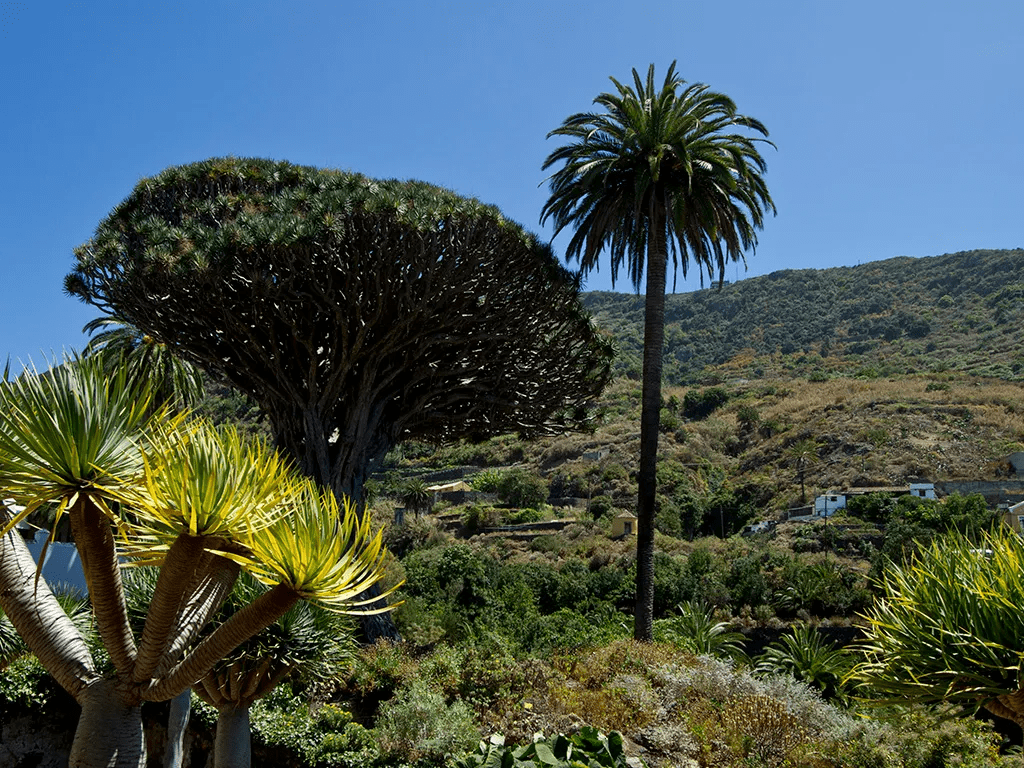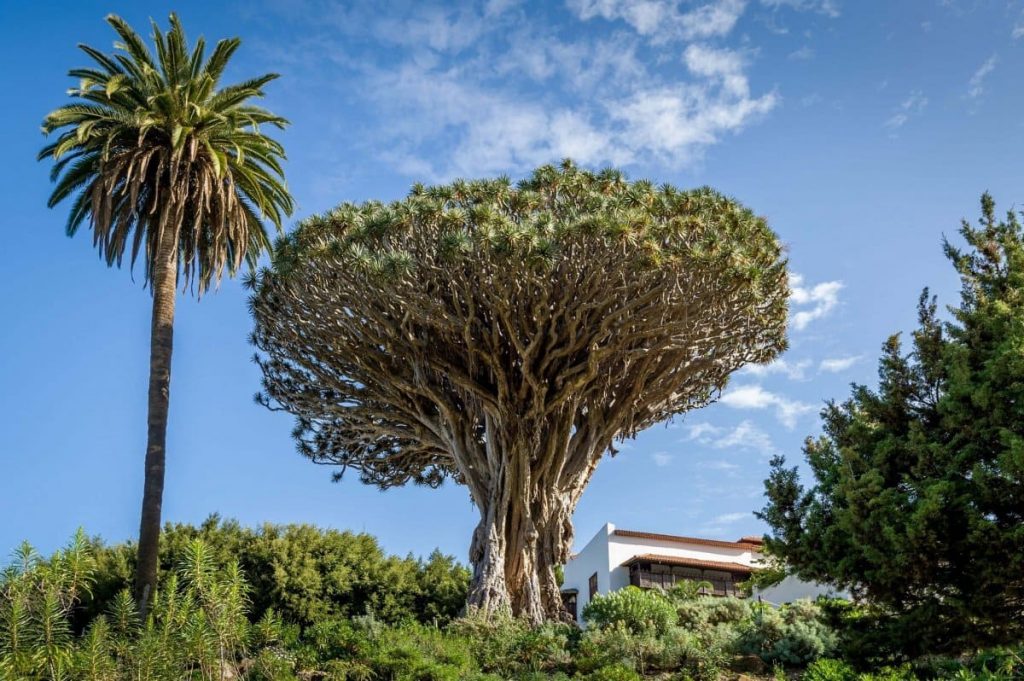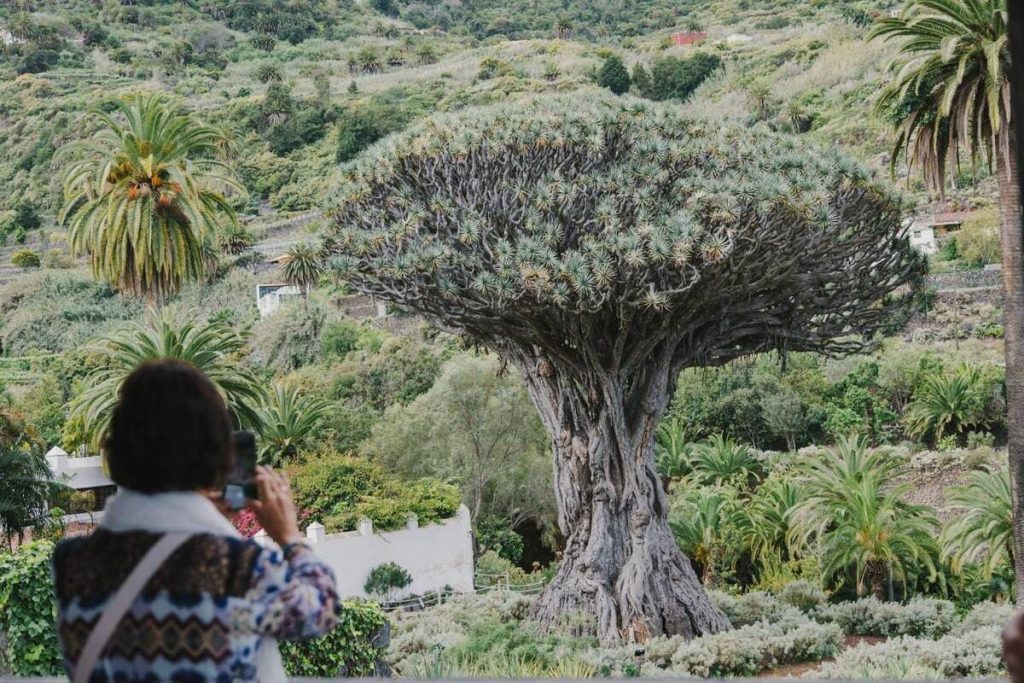Legend has it that dragons turned into dragon trees when they died. This living fossil is deservedly one of the symbols of the Canary Islands and perhaps the greatest treasure of Spanish flora. Given the curious shape of the dragon tree, it is not surprising that it was considered by the ancient inhabitants of the Canary Islands as a divine tree. Among the dragon trees that currently exist in the Canary Islands, one of the best known is the Drago Milenario de Icod de los Vinos, in Tenerife.
The Millenary Dragon Tree, a symbol of the islands
Until recently, dracaena draco was considered endemic to Madeira, the Canary Islands and Cape Verde, however, wild populations have been found in Morocco. Here in the Canary Islands there are several impressive dragon trees. The explorer and naturalist Alexander von Humboldt himself was interested in the dragon tree that stood in the gardens of Franchy in La Orotava at the end of the 18th century, a giant of 25 meters high and 23 meters in perimeter that, unfortunately, was blown down by the wind in 1867. Today, the largest and most famous dragon tree is located in Icod de los Vinos on the island of Tenerife. Known as the Drago Milenario, it measures 17 meters high and 20 meters in perimeter at the base. In addition, its weight is around 150 tons without counting the roots.

The age of the well-known Drago Milenario has been much discussed and it has been claimed that it could be more than five millennia old, however, recent estimates believe that its age does not exceed 800 or 1,000 years.
Its trunk has a huge cavity that rises up to 6 m high, which is accessed through a door. In 1985, the dragon tree was thoroughly cleaned up and a fan was installed inside the trunk to facilitate air circulation and prevent the proliferation of fungi. In 1993, the City Council of Icod diverted the road that passed a few meters from the dragon tree and, fortunately, at present, this plant symbol of the Canary Islands is not in danger.
This dragon tree is the symbol of Icod, as can be seen in the coat of arms of this Canary Island town. In the surroundings of the dragon tree there is a park called "Parque del Drago", which exhibits different endemic plant species of Tenerife. It is also the plant symbol of the island of Tenerife.
The longest-lived dragon tree
The Drago Milenario de Icod de los Vinos was declared a National Monument in 1917. Dragos are tree-like plants belonging to the group of Monocotyledons that have an anomalous secondary growth. It is therefore a woody herbaceous plant, rather than strictly a tree. At present, the Millennial Dragon Tree is the largest and longest-lived known of its kind in the world.
Its flowers are small and numerous. They have 6 petals and as many stamens of creamy green or very pale yellow and raciman in showy inflorescences that protrude from the leaf set. It is estimated that in years of good flowering can produce up to fifteen hundred bunches of flowers.
A park of endemic species around the Drago Milenario (ancient dragon tree)
Around the Drago Milenario is a park of 3 hectares in which a representation of Canary flora is exhibited with cactus, tabaibas, beech, heather, palm trees, dragon trees, aceviños, vinatigos, lindens and laurels, among other species.
The park around the Drago de Icod de los Vinos was designed after an ideas competition held in 1984 by the architects Felipe Artengo, Fernando Menis and José María Rodríguez-Pastrana. Between 1997 and 2000 the biologists and professors of the University of La Laguna, Dr. Wolfredo Wildpret de la Torre and Dr. Victoria Eugenia Martín Osorio collaborated with the architects in the selection of the flora.

The park has other attractions for visitors such as a small volcanic cave, in which an ancient Guanche mummy burial is represented, a wine press with picnic areas and some coal bunkers. In addition, at the foot of the Drago, an area dedicated to the smallest dragon trees was created, called "Guardería de Dragos" (Drago Nursery). It shows the evolutionary process of this species.
The Millenary Dragon Tree and its legend
One remote afternoon, a certain merchant sailor arrived from the Atlantic coasts in search of dragon's blood. A product very in vogue and of great importance in the elaboration of certain preparations of the pharmacopoeia. He disembarked near the beach of San Marcos, in Icod de los Vinos, to carry out his lucrative purpose.
While he was already on the beach, he surprised some infantas or ladies of the land, who, in accordance with the traditional rite, were bathing alone in the sea that summer afternoon. The intruder sailor pursued them, managing to seize one of them. The latter cunningly tried to conquer the heart of the strange traveler in an attempt to distract him and make him flee, and offered him some beautiful fruits of the earth.
For that navigator who came after the blood of the dragon tree, and who carried in his imagination and in his soul the Hellenic myth of the Hesperides, the fruits that the lady offered him could very well have seemed to him like apples from the mythical garden. While he gladly ate, unawares, the beautiful aborigine jumped nimbly to the other side of the ravine.

The traveler tried to chase after it, but saw with surprise that something stood in his way. A strange tree was moving its leaves like infinite daggers and its trunk, resembling the body of a snake, was shaking in the sea wind. When he looked closely he saw that among its tentacles was hidden the beautiful Guanche maiden.
The sailor threw the dart he carried in his hands against what seemed to him to be a monster, with great fear and amazement, and as it stuck in the trunk, liquid blood began to drip from the dragon tree from the end of the javelin. Confused and frightened, the man fled down the hillside, climbed into his small boat and sailed away from the shore, while he was thinking in his heart that he had surprised in the garden one of the Hesperides, whom the mythical Dragon came out to defend.
The Canary Islands is a land with a thousand things to see, explore and learn about. If you are interested in knowing more interesting facts about the Canary Islands, its culture and traditions, we leave you below the link to the section Culture and traditions.
Photos: Cabildo de Tenerife and Canarias 7



